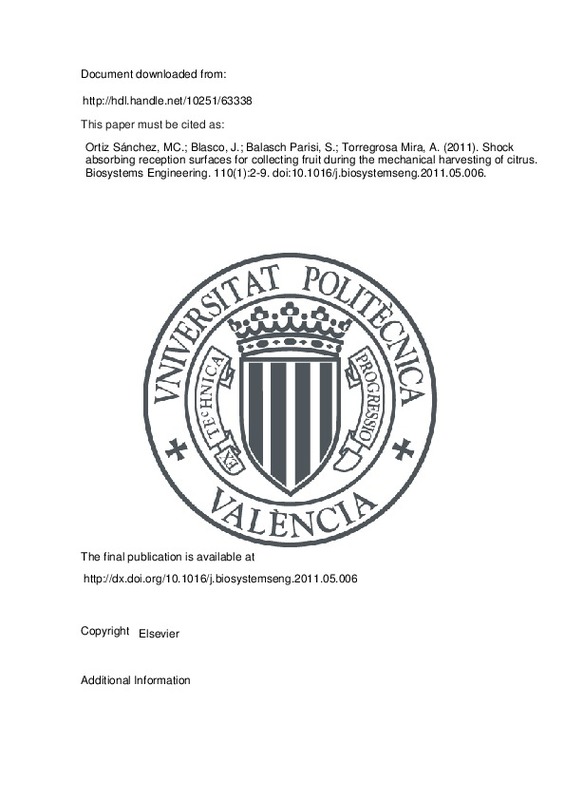JavaScript is disabled for your browser. Some features of this site may not work without it.
Buscar en RiuNet
Listar
Mi cuenta
Estadísticas
Ayuda RiuNet
Admin. UPV
Shock absorbing reception surfaces for collecting fruit during the mechanical harvesting of citrus
Mostrar el registro sencillo del ítem
Ficheros en el ítem
| dc.contributor.author | Ortiz Sánchez, María Coral
|
es_ES |
| dc.contributor.author | Blasco, J.
|
es_ES |
| dc.contributor.author | Balasch Parisi, Sebastià
|
es_ES |
| dc.contributor.author | Torregrosa Mira, Antonio
|
es_ES |
| dc.date.accessioned | 2016-05-02T11:49:16Z | |
| dc.date.available | 2016-05-02T11:49:16Z | |
| dc.date.issued | 2011-09 | |
| dc.identifier.issn | 1537-5110 | |
| dc.identifier.uri | http://hdl.handle.net/10251/63338 | |
| dc.description.abstract | Damage to fresh citrus caused by impact of fruits onto collecting surfaces has restricted the adoption of mechanical harvesting. Two different experiments were carried out: investigating free-falling citrus and investigating the shock absorbing capacity of various surfaces. In free-falling experiment damage to mandarin, orange and lemon was studied. Three collecting surfaces were studied: a concrete floor, an elevated canvas provided with a frame and wheels, and a concrete floor covered with a shock absorbing canvases. Three dropping heights were used. In the shock absorbing experiment, an electronic sphere and a triaxial accelerometer were used to measure the shock capacity of seven receiving surfaces: earth, earth covered with a shock absorbing canvas, earth covered with weeds, earth covered with a mulch and an elevated canvas provided with a frame and wheels. The elevated canvases had a higher shock absorbing capacity compared to the other surfaces (260 m s−2 maximum acceleration compared with 1753 m s−2 to 2772 m s−2). Weeds, mulch and the shock absorbing canvases showed significantly higher shock absorbing capacity than the bare earth. Also, the shock absorbing canvas covering the concrete floor reduce impact and fruit damage (1866 m s−2 maximum acceleration compared to 2477 m s−2). Citrus damage susceptibility during harvest depended on variety. Weeds, mulch and shock absorbing canvases were shown to reduce impact when they cover earth during the mechanical harvesting of citrus. Elevated canvases could be used as collection systems for the mechanical harvesting of fresh citrus. | es_ES |
| dc.description.sponsorship | This study was funded by the Ministerio de Ciencia e Innovacion (research project RTA2009-00118-C02-02) and FEDER. The authors are most grateful to the following collaborators: Maria del Mar Lopez Quevedo, Montano Perez, Juan Jose Pena and Angel Perez. | en_EN |
| dc.language | Inglés | es_ES |
| dc.publisher | Elsevier | es_ES |
| dc.relation.ispartof | Biosystems Engineering | es_ES |
| dc.rights | Reserva de todos los derechos | es_ES |
| dc.subject | Mechanical Harvesting | es_ES |
| dc.subject | Citrus | es_ES |
| dc.subject | Fruit damage | es_ES |
| dc.subject | Electronic sphere | es_ES |
| dc.subject | Reception surface | es_ES |
| dc.subject | Logistic regression | es_ES |
| dc.subject.classification | ESTADISTICA E INVESTIGACION OPERATIVA | es_ES |
| dc.subject.classification | INGENIERIA AGROFORESTAL | es_ES |
| dc.title | Shock absorbing reception surfaces for collecting fruit during the mechanical harvesting of citrus | es_ES |
| dc.type | Artículo | es_ES |
| dc.identifier.doi | 10.1016/j.biosystemseng.2011.05.006 | |
| dc.relation.projectID | info:eu-repo/grantAgreement/MICINN//RTA2009-00118-C02-02/ES/Optimización de los parámetros que afectan al desprendimiento y recogida de frutos cítricos mediante procedimientos mecánicos/ | es_ES |
| dc.rights.accessRights | Abierto | es_ES |
| dc.contributor.affiliation | Universitat Politècnica de València. Departamento de Ingeniería Rural y Agroalimentaria - Departament d'Enginyeria Rural i Agroalimentària | es_ES |
| dc.contributor.affiliation | Universitat Politècnica de València. Departamento de Estadística e Investigación Operativa Aplicadas y Calidad - Departament d'Estadística i Investigació Operativa Aplicades i Qualitat | es_ES |
| dc.description.bibliographicCitation | Ortiz Sánchez, MC.; Blasco, J.; Balasch Parisi, S.; Torregrosa Mira, A. (2011). Shock absorbing reception surfaces for collecting fruit during the mechanical harvesting of citrus. Biosystems Engineering. 110(1):2-9. https://doi.org/10.1016/j.biosystemseng.2011.05.006 | es_ES |
| dc.description.accrualMethod | S | es_ES |
| dc.relation.publisherversion | http://dx.doi.org/10.1016/j.biosystemseng.2011.05.006 | es_ES |
| dc.description.upvformatpinicio | 2 | es_ES |
| dc.description.upvformatpfin | 9 | es_ES |
| dc.type.version | info:eu-repo/semantics/publishedVersion | es_ES |
| dc.description.volume | 110 | es_ES |
| dc.description.issue | 1 | es_ES |
| dc.relation.senia | 212464 | es_ES |
| dc.identifier.eissn | 1537-5129 | |
| dc.contributor.funder | Ministerio de Ciencia e Innovación | es_ES |
| dc.contributor.funder | European Regional Development Fund | es_ES |







![[Cerrado]](/themes/UPV/images/candado.png)

